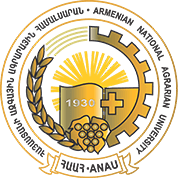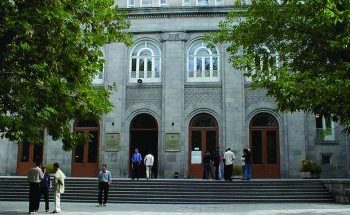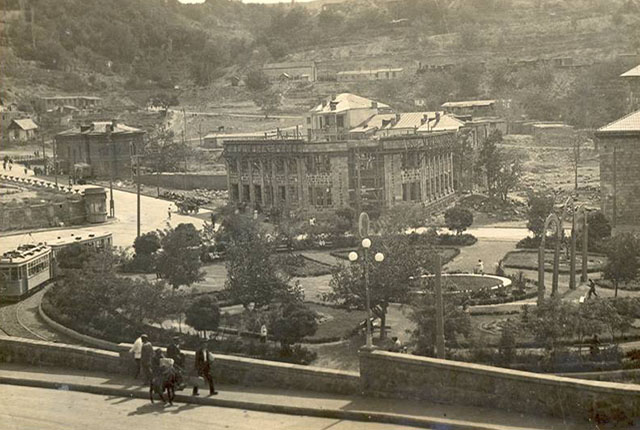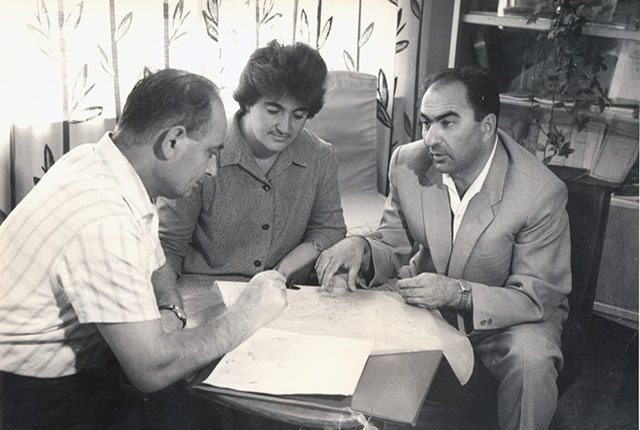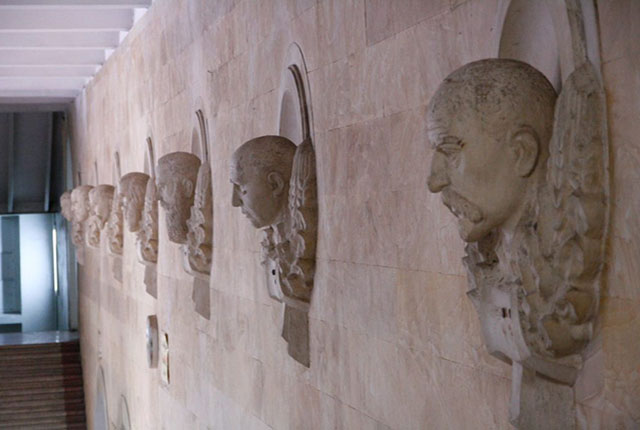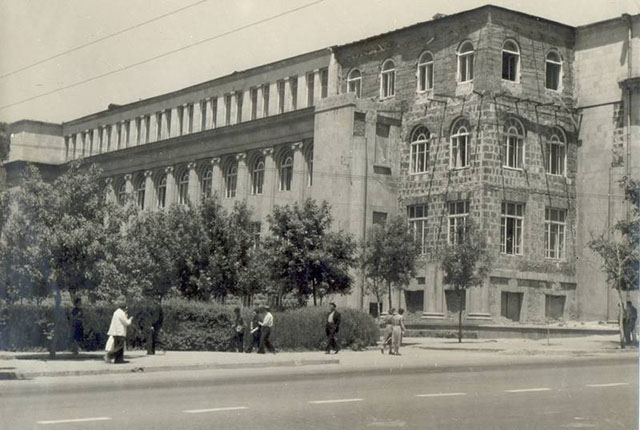The Armenian National Agrarian University is the only higher education institution in Armenia offering education in agrarian and related sectors. In 1994, as a result of merging the Armenian Agricultural Institute and the Yerevan Zootechnical Veterinary Institute, the Armenian Agricultural Academy was founded. Prior to the merge, both institutions, since their inception in 1930, had played a great role in promoting and developing the agrarian sector in Armenia and preparing qualified specialists for the former USSR.
Armenian Agricultural Institute |
In 1930, on July 23, USSR Central Executive Committee and National Communist Council made a decision (N 40/237) to establish Yerevan Agricultural Institute on the basis of Agricultural Faculty of Yerevan State University. In the initial period, about 50 lecturers conducted the classes.
For the first academic year, the institute had three departments:
agricultural,
zootechnical (with animal husbandry and dairy farming specializations)
horticultural:
In the next academic year, the zootechnical faculty with its lecturers was transferred to the Yerevan Animal Husbandry-Veterinary Institute. In the next few years, the faculty of agricultural production organization also operated in the institute.
In order to meet the Republic’s demand, later faculties of Farm Mechanization(1942), Hydro Melioration(1951) and Agricultural Economy(1967) were established. In 1976 the Faculty of Personnel Qualification was established. Part-time education was organized in the Institute in 1932, at first, this type of education was available only for agronomist specialists, and then for all the remaining specialties. The first director of the Institute was S.I. Abovyan (1937-1938, 1956-1967), then the Institute was headed by A.M. Harutyunyan (1938-1940), Kh.P. Mirimanyan (1940-1942, 1953-1956), B.G. Martirosyan (1942-1953), A.S. Tovmasyan (1967-1978), M.A. Gyulkhasyan (1978-1994).
Most of the Institute graduates and lecturers’ names became well-known both in the Republic and outside, among them Academicians: A.A. Matevosyan, G.Kh. Aghajanyan, V.V. Dovlatyan, Professors: Kh. P. Mirimanyan, P.N. Hakobyan, E.M. Movsisyan, D.N. Babayan, S.S. Sahakyan, A.E. Margaryan, H.K. Panosyan, Kh.A. Khachatryan, H.V. Maksapetyan, M.A. Yesayan, Z.A. Melkonyan, A.H. Marukhanyan, P.K. Ter-Zakaryan, S.S. Khachatryan, etc. During the first years there were only 10 departments in the Institute, but further on their number reached up to 34. In 1938 there was Ph.D. Department, and since 1948 the Institute obtained the right of theses defense. The Institute had a rich library – the book fund made over 370 thousand items. Here large-circulation “Gyughatntes” newspaper was published, the first number of which was released in May 1958.
During 64 years of its existence, the Institute gave over 23 thousand graduates and 450 Ph.D. students. Voluminous work was done in training professorate. At the Scientific Councils, there were 21 doctoral and 284 candidate theses defended.
The research work carried out in the Institute was summarized in 53 collected works, over 5550 articles and 90 monographs. Besides, there were published 115 textbooks and manuals, about 800 popular scientific booklets. The staff got 165 author’s certificates and some of the inventions were patented by foreign countries. Under the resolution of the Presidium of the Supreme Council of the USSR, dating October 15, 1980, the Armenian Agricultural Institute was awarded by the Order of “Badge of Honour” for its great contribution to the development of agricultural sciences and training skillful specialists.
Institute of Animal Husbandry and Veterinary Medicine |
In the first half of the 1920s the stock-raising in the Transcaucasian countries was in a critical state, partly, there were no specialized institutions which could raise veterinary and animal breeding on a new level, protecting the population by controlling the zoonotic diseases, as well as work out and introduce new methods of controlling new infectious and non-infectious diseases, improve their breeding and productive abilities. Thus the time urgent requirement was to establish corresponding educational and scientific center.
On June 28, 1928, the Transcaucasian Countries Committee of All-Union Central Executive Committee adopted a resolution to establish Transcaucasian Veterinary Institute in Yerevan, Professor B.G. Masino was assigned to the position of the director of the Institute, and on November 8 the Institute gala opening ceremony took place. The activity of the Institute started with 12 lecturers, including two professors and four assistants.
An interesting fact: in 1930 Professor Noller from Berlin Zooveterinary University, after he had visited to Yerevan Zoo-veterinary Institute, wrote in the magazine ‘Zentralblat Fur Bacteriology” magazine: “The Zoo-veterinary Institute of Transfederation is considered a significant institution in its kind. The foundation of that Institute should be referred to with utmost interest and care, as far as an advanced Higher Educational Institution in Armenian and unique in Transcaucasia is being established, which is considered a bridgehead for zoo veterinary science on the boundary of Turkey and Persia”(Part 1, volume 97, Berlin, 1930).
According to the admission plan for the first academic year, there were 130 seats for students: 25 – for Armenia, 35 – for Azerbaijan, 30 – for Georgia, 30 – for Northern Caucasus and Central Asia, and 10 – for the former soldiers.
From the beginning, there were two faculties at the institute:
veterinary,
animal breeding
in 1961 the department of milk and dairy produce engineering technology was established. The Part-time Education Institute was founded attached to the Institute in 1932, which was reorganized into Part-time Education Department in 1950. Since 1965 the extension department and 1969- the social sciences departments have been formed. In 1971 the preparation department was established.
The founder and the first rector of the Institute was B.G. Masino (1928-1937). Later the Institute was headed by H.P. Meghavoryan (1937-1939), M.H. Martirosyan (1939-1942), G.A. Shakaryan (1942-1955), G.V. Kamalyan (1955-1972), H.H. Madoyan (1972-1978), G.H. Panosyan (1978-1983), M.S. Melkonyan (1983-1994). Throughout the years of the Scientific Councils existence 807 theses have been defended and awarded scientific degrees including 132 doctor’s degrees.
The institute has had a very rich library, the literary fund of which has reached 225 thousand units during the recent years. In 1932 with interruptions, but since 1958 regular publication of the newspaper “For the Staff” started. The institute publishing house was founded in 1946. Throughout its existence the Yerevan Zooveterinary and Animal Husbandry Institute had 16717 alumni.
The Institute’s scientists have carried out tangible scientific research work in the field of animal husbandry, veterinary medicine, dairy production. New high-yielding breeds and types of farm animals have been bred effective methods and remedies for diagnosis of animal diseases, prevention and treatment have been elaborated, new technological solutions for dairy production have been suggested.
The Scientific Research Centre was established in 1974, which included the patent information service.
The results of the scientific-research work carried out at the Institute have been summed up in 64 collected works, 4562 scientific articles, and 87 monographs. 144 textbooks and manuals, 148 science fiction booklets have been published and 136 author’s certificates have been granted. 50 scientific conferences have been held on the scientific research works results, 16 of which were all-union and inter-institutional
According to the decree of Supreme Council of the USSR on November 13, in 1981, the institute was awarded the “Sign of Honor” medal for its services in the field of training qualified specialists for agriculture and the development of agricultural science.
Armenian Agricultural Academy, Armenian State Agrarian University, Armenian National Agrarian University |
According to July 7, 1994 resolution adopted by the Government of the Republic of Armenia the Armenian Agricultural Academy was founded on the basis of Armenian Agricultural and Yerevan Zooveterinary Institutes, which was later renamed into State Agrarian University of Armenia by the Government Resolution N1597, adopted on September 15, 2005. In June 14, 2012 Armenian State Agrarian University was renamed into Armenian National Agrarian University by Government Resolution N 872.
Professor A.Ts. Khachatryan was appointed at the position of the first rector of Armenian Agricultural Academy (1994-1998), in 1998-2018 the university was headed by A.P. Tarverdyan, correspondent member of the RA Academy of Sciences, doctor of technical sciences. From September 25, 2018 to December 26, 2023, the University was headed by Vardan Ediki Urutyan, PhD, Associate Professor of Economics, Associate Professor of Texas A and M University, USA, and from December 26, 2023, according to the decision of the Board of Trustees of ANAU, the performance of the duties of the rector was entrusted to Vice-rector Hrachya Zakoyan in the field of educational activities. Hrachya Zakoyan was the best candidate for filling the vacancy for the position of the rector of the National Agrarian University of Armenia on March 19, 2025. His appointment was confirmed by the RA Government decision on April 17, 2025.
The Agrarian University, being the unique state university in the field of agriculture in Armenia, prepares personnel with higher education in 18 full-time and 16 part-time specialties with a three-level system of training, which enables integrated into the international educational system. Taking into account the peculiarities of agrarian education and the importance of gaining practical knowledge and skills, the RA Government has set the period of four years for getting Bachelor’s degree in all the specialties at the Agrarian University.
In the 2021-2022 academic year, the idea of a working term was introduced for the first time in the higher education system of the country, during which students undergo trial training and perform paid work in partner enterprises and farms of the university.
As of January 1, 2022, the number of full-time students is about 922, in part-time education system there are about 2784 and at the college – 659 students. In all the specialties of the first and second year of Master’s Studies Department 195 students are trained.
The number of full-time and part-time Ph.D. students is 27, most of them being students from the Islamic Republic of Iran and from Syria.
Since September 2018, the Armenian National Agrarian University has entered an active period of reforms. On November 6 in 2018, at the meeting of the ANAU Board of Trustees the new structure of the university, with its departments, was approved. The structural subdivisions of Agrarian University with the available five educational departments are the followings: Agronomy, Veterinary medicine and animal husbandry, Agrarian engineering, Food technology, Agribusiness and economics, as well as: Part-time education and agribusiness departments, Agricultural college after A.Kochinyan, Base Lyceum, Vanadzor, Sisian and Shirak branches. Until 2017, the University had a branch in Stepanakert and until 2020, Russian branches also acted within the University.
The structural subdivisions of the research center are scientific library, food safety and biotechnology, farm mechanizations, electrification and trucking research institutes, “Scientific Centre of Agrobiotechnology”, “Voskehat Educational and Research Centre of Enology”, “H.Petrosyan Scientific Centre of Soil Science, Melioration and Agrochemistry” branches of ANAU Fondation, “Laboratory of Pesticide Synthesis and Plant Protection”, “Laboratory of Veterinary Medicine and Veterinary Sanitary Expertise”, “Laboratory of Genetics, Selection and Feeding of Agricultural Animals”, “Agrarian Policy and Economics” research Centers.
“Zartonk” rest house, “Balahovit”, “Voskehat” experimental farms, Akunq Organic Educational and Experimental Center, wine research center, etc. are operating.
Among the local and international scientific and educational institutions, the unique reputation of the Agrarian University is ensured by the highly qualified professorial potential. There are three professional councils awarding candidate and doctoral scientific degrees at the university: mechanization of agricultural production and mechanisms, agronomy, veterinary medicine and animal husbandry. The abovementioned boards award doctoral and candidate of science degrees in the 5 agrarian professions.
The scientists of Agrarian University carry out a number of research projects in the field of protection and improvement of the genetic fund of valuable varieties of crops and breeds of agricultural animals, veterinary medicine, up-to-date agricultural machines and equipment design, new technologies of processing vegetable and animal raw material and products, ecological, water and land reclamation problems, testing of effective measures and development of measures against plant diseases, plant pests, and weeds, as well as in the field of problems in agrarian economics. In the last few years the University scientists have cooperated with several international educational structures and organized international scientific conferences.
The library of Agrarian University is one of the oldest libraries in the Republic of Armenia. It has 550 thousand units of the book fund of diverse scientific, educational and informational literature published in different countries. Supported by the Food and Agriculture Organization of the United Nations, the electronic library has been operating in the University library since 2004. The necessary conditions are created in several reading rooms equipped with current technological innovations to conduct scientific and creative work. The ANAU history museum also has a variety of exhibition units.
Armenian National Agrarian University staff, entering the 9th decade of its foundation, creates its future with confidence, proudly accomplishing the important mission for our nation and state.
